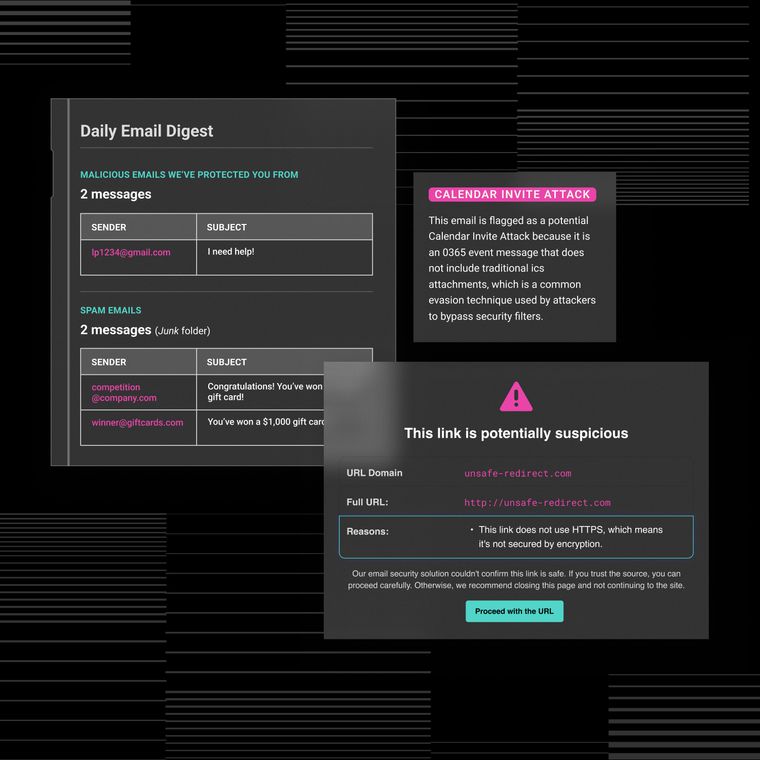TOAD Phishing Attacks: How to Detect and Defend Against Voice-Email Threats
Detect and block TOAD phishing attacks that target people across channels. Protect your organization today.
June 12, 2025
Phishing attacks have evolved into more sophisticated and harder-to-detect threats. Leading the charge is TOAD (Telephone-Oriented Attack Delivery) phishing.
These attacks combine phone calls, emails, and SMS to deliver sophisticated, targeted threats that manipulate human psychology, making them particularly difficult to detect.
For security teams already stretched thin, these attacks exploit human vulnerabilities in a way that conventional defense mechanisms often miss.
What Is TOAD Phishing?
TOAD phishing is an advanced social engineering attack that uses telephone interactions as its primary attack vector, typically combined with communication channels like email and SMS.
TOAD phishing attacks feature several distinguishing characteristics:
Multi-Channel Coordination: Leveraging email, phone, and SMS to craft a cohesive and convincing narrative.
Human Interaction Exploitation: Using voice conversations to manipulate through social dynamics and psychological triggers.
AI-Driven Impersonation: Employing deepfake voice technology to mimic executives and execute sophisticated, AI-powered phishing schemes.
QR Code Manipulation: Using Quishing (QR phishing) to redirect victims to credential harvesting websites.
Hybrid Attack Sequencing: Executing step-by-step tactics across multiple platforms to reinforce deception.
Caller ID Spoofing: Displaying legitimate-looking phone numbers, often mimicking actual company lines.
How Do TOAD Phishing Attacks Occur?
TOAD phishing follows a predictable pattern, which includes:
Initial Contact: A compelling email or SMS with an urgent request or alarming notification.
Voice Interaction: Followed by a phone call that references the initial message, adding credibility.
Trust-Building: Attackers demonstrate knowledge about the victim or company to build trust.
Action Trigger: Requesting sensitive information, financial transactions, or the installation of malware.
Attackers often spoof caller IDs to create a false sense of legitimacy. They exploit emotional triggers like:
Fear: Attackers use scare tactics like telling victims that their accounts have been compromised.
Authority: Attackers impersonate authoritative figures and issue executive orders.
Opportunity: Attackers exploit financial struggles by offering fake financial relief programs.
More recently, some high-profile attacks have started using AI-generated voice and video deepfakes to impersonate company executives, leading to significant financial losses.
For example, a finance employee in Hong Kong was scammed into transferring $25.6 million after a video call with deepfake versions of the company’s CFO and staff, exposing the growing threat of AI-driven scams.
Why Detecting TOAD Phishing Is Crucial
Detecting TOAD phishing attacks is crucial because these attacks bypass traditional security measures and leave victims unaware of their compromised status until damage is done.
The Impact of TOAD Phishing on Organizations
Organizations face three primary types of damage from TOAD phishing attacks:
Financial losses: TOAD phishing attacks frequently lead to direct monetary theft through wire transfers, business email compromise (BEC), or ransomware deployment. The FBI's 2024 Internet Crime Report indicates BEC schemes resulted in losses exceeding $2.7 billion in a single year.
Data Breaches: These attacks excel at credential harvesting, with compromised accounts appearing legitimate because the actual account owner provided their information. A successful TOAD phishing attack provides attackers with persistent access to systems while evading detection.
Reputational Damage: When attackers impersonate an organization's brand or executives, the resulting loss of customer trust persists long after the attack. Research from IBM shows that reputational damage and diminished goodwill are some of the most damaging effects of successful cyberattacks.
Compliance Risks Associated with TOAD Phishing
Beyond immediate operational impacts, TOAD phishing attacks create significant compliance challenges, such as:
Regulatory Disclosure: Data breaches often require regulatory disclosure under frameworks like GDPR and HIPAA.
Negligence Liability: Failure to adequately protect data could increase liability in legal proceedings.
Telecommunications Violations: Using voice recordings in phishing schemes could violate telecom regulations.
AI Deepfake Concerns: The rise of AI-generated deepfakes introduces new legal challenges, with regulations like the European Commission’s 2023 AI Act addressing deepfake technology.
What Are the Detection and Prevention Strategies for TOAD Phishing?
Effective TOAD phishing requires a layered defense strategy that combines cutting-edge technology and human awareness.
Current Detection Methods for TOAD Phishing
Leading organizations use several techniques to detect TOAD phishing:
Behavioral AI: Certain cybersecurity tools use AI to track communication patterns and detect abnormal sequences across channels.
Natural Language Processing (NLP): NLP systems analyze linguistic patterns in communications to flag inconsistencies.
Voice Pattern Recognition: Identifies synthetic voices or voice patterns that don’t match known legitimate callers.
Cross-Channel Correlation: Effective detection integrates data across email, phone, and messaging platforms to identify coordinated attacks.
Mitigation Techniques Against TOAD Phishing
Organizations can implement several strategies to reduce TOAD phishing attack success rates:
Employee Training Programs: Regular simulations of TOAD phishing attacks and engaging employees in cybersecurity help staff recognize warning signs
Technical Controls: Implementing strong multi-factor authentication, DMARC email authentication, and call filtering technologies creates multiple barriers against TOAD phishing attacks
Process Improvements: Establishing verification procedures for high-value requests (like wire transfers) that operate outside the initial communication channel effectively neutralizes TOAD phishing tactics
Cultural Development: Creating an environment where employees feel empowered to question suspicious requests, even from apparent authority figures, reduces successful social engineering attacks
Integrating Security Tools for a Comprehensive Defense Against TOAD phishing
The multi-channel nature of TOAD phishing attacks requires integrated security solutions that offer visibility across communication platforms and automated response capabilities, ensuring comprehensive protection.
Benefits of Automation and Real-Time Threat Detection
Automated security tools that use AI to strengthen cybersecurity provide critical advantages against TOAD phishing attacks, including:
Real-Time Analysis: AI detects attack patterns before they are completed.
Reduced Breach Costs: Organizations with automated security responses can cut breach costs compared to manual processes.
Automated Response: Automated response protocols quickly isolate compromised accounts or block suspicious communications.
Continuous Monitoring: Across channels, automated systems can detect attack patterns that human analysts might miss.
Consistent Responses: Automated security playbooks for common TOAD phishing scenarios ensure uniform and timely action.
Tools That Can Help Prevent TOAD Phishing
Maximum protection against TOAD phishing comes from integrating multiple security tools into a cohesive ecosystem. This collaborative approach forms a defense system stronger and more adaptive than any single tool:
Email Security Platforms: Advanced threat detection systems prevent phishing attacks before they reach the inbox.
Security Information and Event Management (SIEM) Systems: Correlate events across channels, identifying suspicious patterns early.
Endpoint Detection Tools: Monitor unusual device behavior, flagging potential compromise after suspicious interactions.
Shared Threat Intelligence: Continuously updates defense systems with emerging TOAD phishing tactics, keeping organizations ahead of evolving threats.
Staying Ahead of Evolving TOAD Phishing Threats
More attackers are using AI-generated content and deepfakes, making TOAD attacks more difficult to detect. The best defense requires a three-pronged approach: advanced technology, well-trained employees, and clearly defined processes.
Organizations that integrate cross-channel security systems stand the best chance of combating these sophisticated hybrid threats. Also, with the right tools and training, security teams can reduce the impact of these attacks and maintain a strong defense against evolving phishing tactics.
Ready to see how Abnormal protects your inbox from sophisticated multi-channel attacks? Book a demo today.
Related Posts
Get the Latest Email Security Insights
Subscribe to our newsletter to receive updates on the latest attacks and new trends in the email threat landscape.


